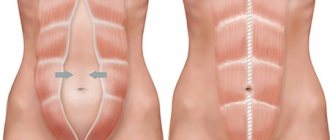Indications and contraindications Operation procedure
Canthoplasty can be combined with different types of blepharoplasty, including canthopexy. A surgical intervention such as canthopexy is performed to tighten the upper and lower eyelids and change the shape of the eyes. It allows you to remove “bags” under the eyes, lift eyelids, eliminate the consequences of injuries, etc. Operations in this group can be performed at any age, starting from 18 years.
Canthopexy and canthoplasty can be:
- lateral (the outer corner of the eye is corrected);
- medial (the shape of the inner corner of the eye changes).
They allow you to eliminate scars from injuries or unsuccessful interventions in the past, and remove skin folds.
Description of the procedure
Canthoplasty is a relatively simple surgical procedure during which the doctor works only on the patient's upper or lower eyelids. The name of the plastic procedure comes from the word “canthus”, which means the corners of the eyes. At the request of the patient, the specialist will make them a little higher or lower. To do this, during the operation, the surgeon touches exclusively the outer layers of the dermis and tightens the tendons, separating them from the cartilage and securing them at the desired level. To correctly fix the new position of the corners, before starting canthoplasty, the doctor will perform special markings.
The opinion that the purpose of such surgical intervention is exclusively aesthetic or rejuvenating is erroneous. Eye contour surgery is often performed for medical reasons. They are based not only on the patient’s desire to change his appearance and overcome complexes associated with defects in appearance.
Before undergoing canthoplasty, you should definitely consult your doctor. A qualified specialist will determine whether the surgery will help eliminate the health problem or not.
Sometimes canthoplasty is confused with blepharoplasty, but these are 2 different operations.
How is canthopexy performed?
The method of performing the operation is very individual.
During a face-to-face examination, the doctor discusses the desired result with the patient, conducts an examination and assesses the amount of work. During the operation, an incision of no more than one centimeter horizontally is most often made above the upper eyelid. This incision helps hide the postoperative cosmetic stitch in the natural crease of the eyelid.
By means of this suture, the surgeon has access to the canthal tendon, which the surgeon subsequently attracts to the ocular periosteum. Again, in some cases, excess skin may need to be excised.
The cost of canthoplasty (canthopexy) is determined after an in-person or correspondence consultation. Approximately $500 for upper OR lower eyelids.
After canthoplasty (canthopexy)
After the operation, there is slight swelling of the eyes, and possible accumulation of blood in the form of hematomas. However, the recovery period is very short: usually within a week, patients can return to their previous work. The pain is minimal and can be relieved with painkillers.
The postoperative suture may subsequently disappear almost completely. In any case, it is absolutely invisible in the natural crease of the eyelid.
The result can be observed immediately after the swelling subsides. The effect of canthoplasty can last more than 10 years.
Our clinics are equipped with the latest equipment, which plastic surgeons have mastered to perfection. That is why the recovery period is minimal, and surgical traces are completely invisible. Another undeniable plus is the complete confidentiality of each patient.
It is necessary to understand that in the case of various plastic manipulations, the qualifications of the doctor are very important . Strict quality control is carried out in Belarus, especially with patients from abroad. Take advantage of the services of our company, because we cooperate with the best doctors and clinics in Belarus
Indications and effectiveness
Correction of the shape, size and contours of the palpebral fissure is effective in the following cases:
- when the patient wants to enlarge naturally narrow eyes and make their gaze more open;
- if you need to raise the corners that have drooped with age, giving your face a “mournful” expression;
- with unsuccessful plastic surgery of the face, eyelids;
- to correct natural features of appearance - round eyes or drooping corners from birth;
- if the palpebral fissure has become narrower after an injury or burn;
- when the patient experiences psychological discomfort due to loose skin of the eyelids or wrinkled mesh around the eyes;
- if the eyeball protrudes too forward (this happens with diseases of the thyroid gland, glaucoma);
- with eversion of the lower or upper eyelid, as well as with their fusion;
- if the palpebral fissures are open asymmetrically.
Attention! As a rule, canthoplasty is performed for rejuvenating purposes after 30 years. For medically prescribed surgery, the patient must be of legal age to undergo the operation.
Preparation for the event
For an initial consultation, you should visit the surgeon who will perform the operation. Together with him you need to discuss the details of the upcoming procedure. The doctor will find out your wishes and model a 3D design of the expected result of canthoplasty.
The specialist will also assess the condition of the skin, general health, and find out whether you have any contraindications to surgical intervention.
A patient who decides to undergo canthoplasty must undergo a short medical examination. It includes:
- fluorography;
- electrocardiogram;
- taking urine and blood tests (including coagulation tests).
10 days before surgery, you should stop smoking and drinking any alcohol, and minimize the consumption of tea and coffee. If you are taking blood thinners, be sure to tell your doctor so that he can temporarily stop taking the medication. Take care of the skin around your eyes. 2-3 weeks before canthoplasty, stop visiting the solarium or sunbathing on the beach. To avoid accidentally injuring the tender area, avoid extreme sports.
If you have problems with your eye health, consultation with an ophthalmologist before canthoplasty is mandatory!
Preparation
At the initial consultation with the surgeon, wishes regarding the result of the procedure are discussed, after which a 3D model is drawn up.
Moreover, it is necessary to undergo a series of tests to get a complete picture of the patient’s health and identify possible contraindications. These include urine tests, as well as general and chemical blood tests. Additionally, fluorography and a cardiogram should be done.
Before the operation, you need to follow a number of rules and adhere to some recommendations.
- Do not drink alcohol for 2 weeks before the procedure. Otherwise, the risk of swelling increases.
- Do not smoke - nicotine thins the blood and disrupts its microcirculation.
- You should stick to your diet. Salty foods, coffee, chocolate, confectionery and citrus fruits are excluded from the diet.
- You will also have to give up some medications: aspirin, paracetamol, diclofenac and ibuprofen due to their property of thinning the blood.
- It is necessary to reduce the level of physical stress on the body and try to first resolve all issues regarding work and everyday problems in order to be able to rest peacefully during the recovery period.
Types of surgery
Depending on what exactly you want to correct in the corners of your eyes or in their shape, the doctor will recommend a certain type of operation.
Canthopexy
Most often, this procedure is used as a synonym for canthoplasty. And yet there are differences between them. The indication for canthoplasty may be the patient’s health problems, while the purpose of canthopexy is purely aesthetic. It is chosen by women and men who, due to age or other changes in the body, need to strengthen their eyelids, eliminate their sagging and eversion. Relatively speaking, this is a surgical tightening of the corners of the eyes. Canthopexy as a type of canthoplasty is characterized by less surgical intervention.
Medial
This variety is also often used for aesthetic purposes. The surgeon works with the inner corner of the eye, changing the shape of the incision. The operation is considered minimally traumatic.
Lateral
This procedure is recommended in cases where you need to correct the outer corner of the eye. Its changes may be due to senile drooping of the eyelid or other reasons. During the operation, it will be possible to eliminate the network of wrinkles, remove skin folds and make the overall facial expression less gloomy and gloomy.
Note! If desired, you can combine medial and lateral types of canthoplasty. Since both operations do not require incisions to muscles and tendons, this simplifies and shortens the recovery period.
Epicanthoplasty
Such an operation may be prescribed for medical or aesthetic reasons. The essence of epicanthoplasty is to remove folds of skin in the inner corners of the eyes. They are called epicanthus, hence the name of the procedure. For Mongoloids and Asians, this fold is considered normal, while among Caucasians it may indicate pathology. The epicanthus runs along the bridge of the nose, connecting the upper and lower eyelids. After surgery, the eyes appear larger and wider.
Is it possible to make almond-shaped eyes with plastic surgery? Plastic surgeons Andrey Stanislavovich Guryanov and Robert Andreevich Guryanov explain the nuances of canthoplasty and canthopexy
First of all, let's deal with what we call "Bella Hadid eyes."
If you look at all the photographs of the model, you will see that the eyes do not always look “foxy”. This means that this is not an anatomical feature, but some kind of trick - makeup, angle. Eyes look most beautiful in photographs where the head is slightly tilted.
In the top photo the head is tilted (+makeup), in the bottom there is no tilt.
Slightly slanted eyes are called almond-shaped; this is a desirable shape for many women. But let's look at what makes Bella's eyes so beautiful from an anatomical point of view.
The outer corners of her eyes are deeper (relative to the horizontal center line, red in the picture) than the inner ones. Therefore, with a minimal tilt of the head, it begins to seem that the outer corners of the eyes are higher, that is, the eyes look slanted. And the appropriate makeup makes them even more expressive.
If you draw a straight line through the inner and outer corners of the eye, then it forms an angle with the horizontal, which is called the angle of inclination of the palpebral fissure (in English tilt). It is believed that normally this angle should be from 0 to 4 degrees. The greater the angle of inclination, the more slanted the eyes appear. Almond-shaped eyes always have an angle greater than 0 degrees.
Angle of inclination of the palpebral fissure. A straight line drawn through the inner and outer corners of the eye makes an angle from 0 to 4 degrees with the horizontal.
The perception of eye size and shape is based on many illusions.
Let's look at what elements create the beauty of the eye. After all, almond shape is far from the only factor that makes eyes beautiful.
1. Position and length of the eyebrow.
Raising the tail of the eyebrow creates the illusion of lengthening the eye and raising its outer corner.
The overhang of the upper outer edge of the orbit, head and body of the eyebrow greatly obscures the eyes and creates the appearance of sunken eyes.
The long furrow of the upper eyelid creates the illusion of a long eye. The inclination of the sulcus also influences the perception of eye tilt.
2. The depth of the eyeball in the orbit.
With the same length, deep-set eyes are perceived as small, narrow, and bulging eyes as large and beautiful. This happens because with protruding eyeballs, the area of the scleral triangles (especially the outer one) is larger.
3. With high height of the lower eyelid
and contouring of the lower orbital edge (due to shadows) the eyes appear larger.
4. When partially covered with epicanthus
The inner corner of the eye makes the eyes appear shorter:
5. For large cheekbone widths
(interzygomatic distance) eyes appear smaller:
The perception of the size and shape of the eyes is influenced by the shape and fullness of the subeyelid region, the delineation of the edge of the orbit, as well as the severity and length of the upper eyelid furrow.
But here are the structural elements of the eyes themselves, which affect their perception:
1. The length of the palpebral fissure.
2. The inclination of the palpebral fissure.
3. Area of the outer canthal triangle.
4. Area of the internal scleral triangle.
5. Lower scleral stripe.
6. Lateral canthal angle.
To understand the following text, you need to understand the terms and definitions:
Lateral canthus
- The area at the outer corner of the eye where the upper eyelid meets the lower eyelid.
Lateral suture of eyelids
– the place where fibrous fibers and the orbicularis muscle of the upper and lower eyelids meet.
Cantholysis
– release of the canthal ligaments from the lateral edge of the orbit. This is done in order to stretch, move up or down the angle of the palpebral fissure.
Canthotomy
– horizontal dissection of the external canthus to lengthen the palpebral fissure.
Two anatomical structures are responsible for fixing the outer corner of the eye. These are the superficial and deep canthal ligaments. They are otherwise called the canthal tendon and the canthal ligament. They attach the upper and lower eyelids to the orbital bone. The superficial ligament is attached to the very edge, and the deep ligament is approximately 5 mm deeper.
The superficial lateral (outer) canthal ligament attaches the eyelids to the orbital bone. Below it is a deep ligament.
To change the position of the external canthus, strengthen it and increase the tone of the eyelids, external canthoplasty surgery is used. This name combines several procedures that solve different problems, including changing the inclination of the palpebral fissure and increasing its length.
What techniques are used for plastic surgery of the outer corner of the eye (outer canthus)?
Canthopexy
This is fixation, suspension to the periosteum or bone of the orbital edge of the external canthal ligaments or orbicularis muscle. Without their intersection.
Canthopexy. Fixation of the canthal ligaments (in this case to the bone) without crossing them in order to strengthen the external connection and increase the tone of the lower eyelid.
Canthoplasty
This is a modification of the canthal ligaments, their destruction (cantholysis) with subsequent fixation to the periosteum or the outer edge of the orbit.
Canthoplasty. Fixation of the canthal ligaments (in this case to the bone) after their intersection in order to shorten or significantly move the outer corner of the eye.
Canthotomy – horizontal dissection of the canthus
Horizontal dissection of the canthus allows you to lengthen the palpebral fissure and change the angle of the lower eyelid.
It is surgically possible to make the eyes more slanted and larger using lateral canthoplasty. However, the surgical techniques for lateral canthoplasty are different in young, Asian and older patients.
Manipulations with the lateral canthus during age-related plastic surgery of the lower eyelids and their reconstruction are aimed at restoring the tone of the lower eyelids, eliminating the lower scleral strip (correction of the so-called “round eye”), restoring or slightly raising the outer canthus without significantly changing the shape of the canthal angle.
Canthoplasty of age eyelids.
Reduced tone of the eyelid, appearance of a scleral border, rounding of the palpebral fissure.
Canthoplasty or canthopexy eliminates age-related deformation of the eyelids. Asian eyes are characterized by a narrow palpebral fissure and an oblique lower eyelid. Lateral canthoplasty of Asian eyes is aimed at reducing the height of the external canthus, horizontally lengthening the palpebral fissure, and expanding the area of the external scleral triangle. For this purpose, canthotomy and cantholysis are performed.
Horizontal dissection of the canthus, partial destruction of the canthal ligament of the lower eyelid leads to a downward displacement of the edge of the lower eyelid. All that remains is to fix it with a suture to the periosteum.
Lateral canthoplasty of Asian eyes: lengthening of the palpebral fissure, expansion of the outer scleral triangle.
To create Bella Hadid's eyes, on the contrary, it is necessary to increase the height of the outer canthus and horizontally lengthen the palpebral fissure. And at the same time, maintain or increase the area of the outer scleral triangle so that the eyes do not turn out to be squinted.
Narrowing of the palpebral fissure and reduction of the external scleral triangle with elevation of the external canthus. Despite the fact that the palpebral fissure has become longer, the eye looks small.
The lateral angle of the eye is raised, the outer scleral triangle has become larger.
For normal, deep-set and bulging eyes, various surgical techniques are used.
The structural features of the orbit can become a limitation for performing lateral canthoplasty in European eyes. Insufficient orbital width or overhang of the superior outer bony margin may require bone resurfacing.
a) The small width of the orbit may be an obstacle to increasing the length of the palpebral fissure. In this case, the orbit is expanded by grinding off its inner wall.
b) The overhang of the superolateral bony edge of the orbit in the form of a visor may interfere with the elevation of the outer corner of the eye, and then the bony edge is ground off.
Enlargement of European eyes
- not an easy task, since it is necessary to take into account the shape of the orbit, the position of the outer edge of the eyebrow and, as a rule, the high tone of the eyelids. The high tone of the eyelids, as well as gravity and contraction of the orbicularis muscle when closing the eyes, place high demands on fixation of the outer canthus. Therefore, it should be attached exclusively to the bone.
To communicate with patients who have undergone facial rejuvenation, come to our forum, section Anti-aging surgeries
Operation stages
Canthoplasty is performed under general or local anesthesia. Many doctors prefer the first option because it avoids unforeseen situations during the procedure . The operation itself to change the shape and shape of the eyes usually lasts no more than 1–2 hours and includes the following stages:
- Marking. The surgeon marks areas that require correction. The scope of work is discussed with the patient in advance.
- Treatment of eyelids with an antiseptic.
- Introduction of anesthesia.
- Cutting the skin. Depending on the canthoplasty technique chosen, the doctor makes an incision in the dermis of the upper or lower eyelid along the growth of the eyelashes or from the side of the conjunctival sac. The length of the incision does not exceed one centimeter.
- Through the incision, the doctor tightens or loosens the tendons that are responsible for the size of the palpebral fissure.
- Similar manipulations are carried out with muscles.
- If necessary, the doctor removes excess fat or skin folds (this can form during the canthoplasty process).
- The surgeon stitches the wound and applies a bandage to the eyelid.
Canthoplasty is often combined with other procedures: blepharoplasty, forehead lift, etc.
The doctor may make the incision surgically or with a laser. The latter option is optimal for both participants in the operation: it is more convenient for the surgeon to work with a laser, and the patient tolerates such intervention more easily. In addition, there are almost no visible seams on the skin. If the procedure went without complications, after the anesthesia wears off, the patient can go home accompanied by loved ones. Some visitors prefer to stay in the clinic for a couple of days.
Despite the fact that canthoplasty is considered one of the least complex operations, take your choice of plastic surgery clinic and doctor seriously. Read the reviews and be sure to talk to the doctor in person. Make sure you trust your health and appearance to an experienced and qualified professional.
Canthoplasty (canthopexy) - correction of eye shape
Plastic surgery does not stand still, so every day people all over the world have a chance to become more perfect.
Recently, the procedure of canthopexy and canthoplasty has become very popular. Canthopexy and canthoplasty allow you to change the shape of the eyes, tighten the corner of the eyelids, thereby achieving an aesthetic appearance of the entire face. The procedure received its name due to the fact that any operation performed in one way or another affects the canthal tendon in the eyelid area, which is responsible for support.
This procedure is most popular among people who have severe ptosis (sagging eyelids) and too narrow/wide eye shape. Canthoplasty is also suitable for those who have drooping eyelids due to age-related changes. Canthopexy helps to “rejuvenate” the look, since the procedure tightens the lower eyelid and also removes ectropion (a case where the eyelid is slightly inverted).
Postoperative period
Immediately after the procedure, bruising and swelling in the eyelid area appear on the face. These are inevitable consequences of surgery. It will take about a week to eliminate hematomas and swelling. To eliminate discomfort, you can take analgesics and apply cold compresses to your eyelids.
The stitches will be almost invisible because the incision during surgery is made in a natural crease. Until they heal completely, the area should be treated with an antiseptic. 3–5 days after canthoplasty, the patient will notice only a thin red thread on the eyelid. After a couple of months, she too will disappear. The scar is small, so it will heal quickly.
Rehabilitation after surgical canthoplasty lasts about 2 weeks, after laser - up to 10 days. It will take about a month to fully recover from surgery. But after 1–2 weeks, you can see changes in your appearance: your face looks rested and more youthful, your skin becomes elastic, the corners are tightened, and there are no bags under your eyes.
Important point! The effect of the operation lasts for 7–10 years. If necessary, canthoplasty can be repeated.
What is medial canthoplasty?
The differences between lateral and medial canthoplasty lie in which ligaments the surgeon touches during surgery. Most often, lateral correction is performed; it allows you to change the shape of the eyes, get rid of various aesthetic imperfections, and eliminate defects resulting from aging.
If there are scars or pathology of skin folds, medial canthoplasty is performed. Unlike lateral correction, this operation involves working with the inner corner of the eye. For example, this type of correction is often used when changing an Asian eye shape to a European shape.
Medial canthoplasty makes the eyes more open. During the operation, the surgeon moves the tendon of the eye to lift the corners of the eyelids, fixing it in a new position and carefully suturing the incisions with cosmetic sutures. If necessary, excess skin folds are excised.
Restrictions after surgery
At the stage of primary rehabilitation, which lasts 10–14 days after canthoplasty, it is important to follow the following medical instructions:
- Sleep in a supine position with your head slightly elevated.
- Avoid wearing contact lenses.
- Do not wear makeup, especially eyelid cosmetics.
- Wear sunglasses.
- Avoid sudden movements, physical strain (including increased sexual activity).
- Do not take hot baths, avoid solariums, swimming pools, and the beach.
- Take care of your eye health! Prevent them from overworking: work less on the computer, read, watch TV.
- Reduce the amount of coffee you drink.
- Give up alcohol and cigarettes.
- Visit your doctor, who will monitor the wound healing process and, if necessary, advise the patient on eye exercises.
Side effects and complications
In the first days after surgery, a person may feel dryness, irritation, and discomfort in the eyes. These are side effects that will go away soon, as will bruising and swelling. It is much worse if, after canthoplasty, the patient develops serious complications:
- infection of the wound, suppuration;
- seal in the seam area;
- persistent dry eye associated with damage to the tear duct;
- eversion of the eyelid if muscles or tendons were severely tightened during canthoplasty;
- bleeding or sutures coming apart (if they are not applied too tightly);
- non-closure of the eyelids - occurs when excessive excision of the skin;
- the appearance of post-traumatic pigmentation.
Important! Immediately after canthoplasty, the patient may feel that his eyes have become asymmetrical. This may be normal because recovery is uneven. But if everything remains the same within 30 days after surgery, you will most likely need a second surgery.
The surgeon’s impeccable work and the patient’s correct behavior during the rehabilitation phase are the guarantee that the patient will not encounter unpleasant consequences of canthoplasty.
Rehabilitation period
Complete restoration of the skin occurs within 2-3 weeks. During this time, a thin pink line forms at the site of the incision.
The appearance of slight swelling and hematomas is acceptable, which usually disappear within 7 days.
The patient may also experience other discomforts:
- tearfulness;
- burning;
- photosensitivity;
- hypersensitivity.
You can alleviate the condition by applying cool compresses based on herbal infusions.
It is important to follow the doctor's recommendations:
- At first, it is forbidden to use lenses and influence the eyelids and mucous membrane in any other way, such as simply touching this area with your hands.
- The strain on the eyes and the body as a whole should be reduced. The ban includes going to the gym, reading literature and watching TV.
- You cannot visit the sauna, solarium or sunbathe in natural conditions.
- It is also recommended to control head movements and avoid sudden bends. It is better to sleep on a high pillow to normalize the outflow of lymph in the required quantities.
To speed up the healing period, the doctor may prescribe special ointments that help eliminate swelling and bruising, as well as reduce pain. Additionally, he prescribes eye drops that help prevent the appearance of “dry” eyes.
Contraindications
The operation should not be performed on people who:
- patients with oncology or any autoimmune disease, epilepsy;
- have problems with blood clotting;
- suffer from severe myopia;
- have disturbances in the functioning of the endocrine and cardiovascular systems.
Conjunctivitis, inflammation of the skin around the eyes, exacerbation of a chronic illness, recent infection or stress, as well as pregnancy and lactation are all also contraindications for surgery.
Indications for use
Changes in the periorbital area are primarily due to the fact that the skin around the eyes is thin and sensitive.
Its condition is negatively affected by environmental factors (UV rays and ecology), and excessive facial stress and even genetics are also of great importance. In the latter case, the main indication for surgical intervention is the client’s desire to change his appearance to meet beauty standards - this is not necessarily associated with age-related deformities.
It is believed that the outer corner of the eye should be slightly higher than the inner corner (no more than 3 mm).
It is recommended to resort to blepharoplasty with canthopexy in the case of:
- signs of ptosis;
- deformation of the outer eyelid due to weakening of tendons and muscles;
- chronic inflammation;
- inversion of the lower eyelid after unsuccessful blepharoplasty or previous paralysis;
- diseases of the conjunctiva;
- the need to tighten tendons and stabilize muscles;
- blepharophimosis;
- “bulging” eye syndrome accompanying myopia;
- fatty hernias;
- pathologies of the eyelids of a congenital nature (for example, partial fusion);
- eye asymmetry.
Alternative procedures
If you do not want to do canthoplasty, you can use other methods of correcting the appearance of the eyes:
- Blepharoplasty is the removal of fatty deposits and excess skin on the eyelids. You can perform not traditional, but modern laser correction.
- Hardware plasma lifting is a tightening of problematic skin using a special device (plasma liner, plasma jet, etc.).
- Thread lifting is the introduction of special threads into the dermis through thin punctures.
- Proper makeup is the safest, absolutely harmless and most affordable way to make your eyes more expressive.
By the way, representatives of the Mongoloid race, wanting to acquire a “European” eye shape, most often choose sangapuri - correction of the upper eyelid, during which a decorative fold is formed.
Advantages and disadvantages
The advantages of canthoplasty are obvious:
- the look becomes lighter, more open;
- bags under the eyes disappear;
- the shape and size of the incision changes;
- the outer corners of the eyes rise;
- wrinkles are smoothed out;
- eye asymmetry goes away;
- the skin gains firmness and elasticity;
- pressure on the eyeballs decreases.
Having made a choice in favor of surgical intervention, remember the disadvantages of canthoplasty:
- quite high cost - the clinic will tell you the exact amount you will have to pay;
- presence of restrictions;
- risk of complications;
- the need for lifestyle correction before and after canthoplasty;
- It’s not an easy decision to decide where and from whom to perform a high-quality operation.
Experts' opinion
Canthoplasty is not a cosmetic procedure. It is performed only by plastic surgeons with appropriate qualifications. Sometimes their range of services includes correspondence consultations with potential patients.
The doctor explains that in some cases it is appropriate to replace canthoplasty with other operations.
Service cost
Blepharoplasty with canthopexy is not a cheap pleasure. Average cost of the procedure: 30-40 thousand rubles.
The following factors influence the final amount:
- development of the city's infrastructure;
- level of competition;
- the specifics of the clinic (multidisciplinary ones in most cases have a more loyal pricing policy);
- personnel qualifications;
- selected anesthesia and disinfectant;
- scale of the operation.
Patient reviews
Despite the fact that in some clinics plastic surgeons provide online consultations and explain the features of the procedure, many patients do not know what canthoplasty is. Without sufficient reliable information, users make guesses about the essence of this operation. The doubts of the forum visitor are understandable: there are not many real reviews about canthoplasty.
Not only women are interested in the procedure, but also men who also do not find relevant answers to their questions.
There are also positive opinions. The girl solved a long-standing problem with the help of canthoplasty and was satisfied.
This patient underwent blepharoplasty and canthoplasty simultaneously. In general, she was satisfied with the result, but there were some negative aspects.
Based on her experience, the woman advises the operation to be performed under general anesthesia.
Any operation is a psychological stress for a person and a test for his body, even if we are talking about a seemingly harmless correction of the eye shape. Depending on the indications, canthoplasty will improve your eye health, make you look younger, or get rid of long-standing complexes. But provided that you are in the hands of a competent doctor. One who can correctly set up a patient for surgery and perform it without complications.
Take the time to find a qualified doctor and don’t skimp on yourself. If canthoplasty is successful, you can forget about correcting the shape and shape of your eyes for the next few years.
Opinion of cosmetologists
The majority of specialists express only a positive opinion regarding blepharoplasty with canthopexy. They note that this is a fairly simple method of intervention, as a result of which the appearance is noticeably transformed.
A plastic surgeon consults a potential client and talks about an individual approach in any case:
The specialist talks about the possible need to replace canthoplasty with other procedures:










